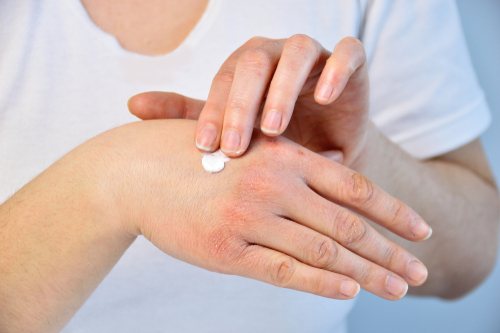Efficacy of Cream in Control Group May Explain ESSENCE Trial Failure, Study Reports
Written by |

An analysis of the control group from the ESSENCE Phase 3 clinical trial, which tested the topical cream SD-101 in people with epidermolysis bullosa (EB), found overall improvements in wound closure and less pain over a three-month period.
The unexpectedly high response rate in these patients may help explain why SD-101 was found not to be superior to the vehicle — a similar cream but without allantoin, the active ingredient being studied.
The analysis was reported in a study, “Wound closure in epidermolysis bullosa: data from the vehicle arm of the phase 3 ESSENCE Study,” published in the Orphanet Journal of Rare Diseases.
SD-101 is a topical cream developed by Amicus Therapeutics to treat skin blistering and lesions in patients with EB. The cream contains 6% allantoin, a natural product thought to promote wound healing and reduce blistering and itching.
The efficacy of SD-101 was tested in the ESSENCE trial (NCT02384460), sponsored by Amicus, in which participants were randomly assigned to receive SD-101 or a vehicle — acting as a placebo — which was applied to the whole body once daily for 90 days, or three months.
A total of 155 patients completed the study, 75 in the SD-101 group and 80 in the control group.
Results showed that SD-101 failed to show statistically significant improvement in wound healing compared to the vehicle cream. Likewise, no benefits were found in pain or itching.
An analysis found a higher-than-expected placebo response rate in patients given the control cream, which increased over time. Researchers then suggested that lanolin oil and cod liver oil, which were components of the vehicle cream and have known skin healing properties, could have driven the unexpected effects.
In addition, the daily application of a topical cream to the entire body may have contributed to these improvements, as the degree of skin care during the trial may have been higher than usually practiced at home.
Despite the failure of SD-101, treatment with the vehicle cream provided an opportunity to gather information on the natural history of wound closure and other clinical outcomes in people with EB.
Participants given the vehicle cream ranged in age from 2 months to 67 years. Eight had EB simplex, 62 were diagnosed with dystrophic EB, and 17 had junctional EB. At baseline, wound size varied considerably from 7.8 to 302 cm2 . Adults and patients with junctional EB had the most chronic wounds.
The mean average of wound burden, as measured by the body surface area index (BSAi), was 10.5%.
Besides lanolin oil and cod liver oil, the vehicle cream contained citric acid, methylparaben, and cetyl alcohol, among other products.
In participants who received the vehicle cream, the mean time to wound closure within three months was 53.6 days, and ranged from 14 to 142 days. The proportion of patients with wound closure increased over time from 7.1% at day 14 to 53.6% at day 90.
This group reported reductions in skin lesions and total body wound burden over the study period. The mean decrease in BSAi from baseline was 5%. In turn, mean total wound burden reduced by 2.3% during treatment.
Reductions in pain and itching were reported on day seven and were maintained over the three months.
Mean time to wound closure was shorter at 43.8 days in patients younger than 2, compared with 56.4 days for those 2 to 11 years old, 53.4 days for patients 12 to 17, and 52.8 days for adults.
The youngest age group also had the largest proportion of participants achieving complete wound closure at month three (83.3%).
Wounds lasting up to 30 days closed faster (46.7 days) than longer-lasting wounds (60.7 days). Notably, 23 of 24 (95.8%) patients with wounds lasting not more than one month attained closure within 90 days compared with 22 of 60 (36.7%) patients with older wounds.
In patients with a BSAi under 5%, the mean time to complete wound closure was shorter than in those with a higher total wound burden. A greater proportion of patients with less than 5% wound burden achieved wound closure within three months compared with those who had a higher BSAi (73.3% vs. 41.5%).
A comparison of EB types found that wound closure times were shorter in participants with recessive dystrophic EB (49.4 days) than those with EB simplex (73.6 days) or junctional EB (56 days). After 90 days, the proportion of patients with complete wound closure was similar for EB simplex and junctional EB, and slightly lower for dystrophic EB patients.
“Treatment response observed in the vehicle-control arm of the ESSENCE study was unexpectedly high, with overall improvements observed in target wound closure, lesional skin and total body wound burden, itch, and pain over the 3-month treatment period,” the scientists wrote.
“These observations are of considerable interest and may help inform the study design of future trials in patients with EB, which may benefit from a vehicle run-in phase to exclude patients who respond to vehicle controls or improved wound care,” they added.





